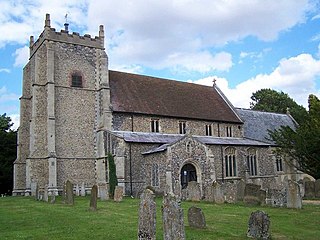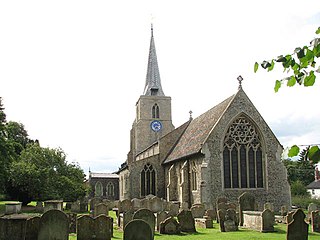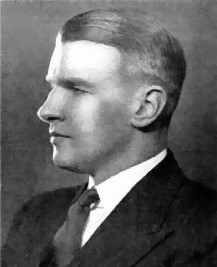
William John Battersby JP (30 June 1839 – 22 February 1915) was a British hat manufacturer, of Battersby Hats.

William John Battersby JP (30 June 1839 – 22 February 1915) was a British hat manufacturer, of Battersby Hats.
William John Battersby was born in Edward Street, Stockport in 1839, the son of William Battersby (1797–1851) and his wife Sarah Norfolk. He married Mary Oldham (4 Mar 1840, Stockport – 5 March 1909, Stockport), and they had eleven children, nine of whom survived infancy: [1]
Edgar and three of his brothers became directors or managers at Battersby Hats. [1]
His grandson was British fascist James Larratt Battersby.
Battersby was awarded a patent in 1896, for "Improvements in and connected with Hats, Caps, and similar Head Coverings", along with his son William Norfolk Battersby. [7] He was awarded another patent in 1900, for "Improvements in Machines for Curling and Ironing Hat Brims", along with Edward Edwards. [8]
He was also a Justice of the peace. [9]

Stockport is an industrial town in Greater Manchester, England, 7 miles (11 km) south-east of Manchester, 9 miles (14 km) south-west of Ashton-under-Lyne and 12 miles (19 km) north of Macclesfield. The River Goyt and Tame merge to create the River Mersey here. It is the main settlement of the wider Metropolitan Borough of Stockport.

RMS Lusitania was a Lusitania-Class ocean liner that was launched by the Cunard Line in 1906 and held the Blue Riband appellation for the fastest Atlantic crossing in 1908. It was briefly the world's largest passenger ship until the completion of the Mauretania three months later. She was sunk on her 202nd trans-Atlantic crossing, on 7 May 1915, by a German U-boat 11 miles (18 km) off the southern coast of Ireland, killing 1,199 passengers and crew.

A top hat is a tall, flat-crowned hat traditionally associated with formal wear in Western dress codes, meaning white tie, morning dress, or frock coat. Traditionally made of black silk or sometimes grey, the top hat emerged in Western fashion by the end of the 18th century. Although it declined by the time of the counterculture of the 1960s, it remains a formal fashion accessory. A collapsible variant of a top hat, developed in the 19th century, is known as an opera hat.

A hat is a head covering which is worn for various reasons, including protection against weather conditions, ceremonial reasons such as university graduation, religious reasons, safety, or as a fashion accessory. Hats which incorporate mechanical features, such as visors, spikes, flaps, braces or beer holders shade into the broader category of headgear.

A fedora is a hat with a soft brim and indented crown. It is typically creased lengthwise down the crown and "pinched" near the front on both sides. Fedoras can also be creased with teardrop crowns, diamond crowns, center dents, and others, and the positioning of pinches can vary. The typical crown height is 4.5 inches (11 cm). The term fedora was in use as early as 1891. Its popularity soared, and eventually it eclipsed the similar-looking homburg.

Akubra is an Australian hat manufacturer. The company is associated with bush hats made of rabbit fur felt with wide brims that are worn in rural Australia. The term "Akubra" is sometimes used to refer to any hat of this kind, however the company manufactures a wide range of hat styles including fedora, homburg, bowler, pork pie, and trilby.

A mobcap is a round, gathered or pleated cloth bonnet consisting of a caul to cover the hair, a frilled or ruffled brim, and (often) a ribbon band, worn by married women in the 18th and early 19th centuries, when it was called a "bonnet". These caps were always gathered to a flat, often curved, brim. The caul had a flat bottom and curved top. The bottom was typically gathered to fit the back neck with a drawstring, while the curved sides and top were tightly gathered and stitched to the brim, which typically had some curves, too. Originally an informal style, the bonnet became a high-fashion item as part of the adoption of simple "country" clothing in the later 18th century. It was an indoor fashion, and was worn under a hat for outdoor wear.

Carleton Rode is a village and civil parish in Norfolk, England. It is situated approximately five miles south-east of Attleborough. In the 2011 Census, Carleton Rode was recorded as having a population of 785 people in 324 households.

The Hat Works is a museum in Stockport, Greater Manchester, England, which opened in 2000. Before that, smaller displays of hatting equipment were exhibited in Stockport Museum and in the former Battersby hat factory.

Fashion in the period 1900–1909 in the Western world continued the severe, long and elegant lines of the late 1890s. Tall, stiff collars characterize the period, as do women's broad hats and full "Gibson Girl" hairstyles. A new, columnar silhouette introduced by the couturiers of Paris late in the decade signaled the approaching abandonment of the corset as an indispensable garment.

Fashion from 1910 to 1919 in the Western world was characterized by a rich and exotic opulence in the first half of the decade in contrast with the somber practicality of garments worn during the Great War. Men's trousers were worn cuffed to ankle-length and creased. Skirts rose from floor length to well above the ankle, women began to bob their hair, and the stage was set for the radical new fashions associated with the Jazz Age of the 1920s.

Conty is a commune in the Somme department in Hauts-de-France in northern France.

Banham is an English village and civil parish in the county of Norfolk, about 7 miles (11 km) north of Diss, 12 miles (19 km) east of Thetford and 20 miles (32 km) south-west of Norwich. It is home to Banham Zoo, a private collection open to the public for more than 40 years, which houses over 2000 animals. The Church of England parish church, dedicated to St Mary the Virgin, is a Grade I listed building. The name of the village derives from "Bean homestead/village", or perhaps "hemmed-in land where beans grow".

Captain William Thomas Turner was a British merchant navy captain. He is best known as the captain of RMS Lusitania when she was sunk by a German torpedo in May 1915.

James Larratt Battersby was a British fascist and pacifist, and a member of the Battersby family of hatmakers of Stockport, Greater Manchester, England. He was forced to retire from the family firm due to his politics and was interned by the British government during the Second World War along with other British fascists. During his detention he came to believe that Adolf Hitler was Christ returned, and after the war wrote The Holy Book and Testament of Adolf Hitler. He committed suicide by leaping into the paddle wheels of a ferry.

Battersby Hats was the trading name of Battersby & Co, a hat manufacturer of Stockport, England. The firm once had a capacity of 12,000 hats per week but it declined in the second half of the twentieth century and merged with other hat manufacturers in 1966 before hat production ceased altogether in 1997.

James Johnson Battersby (1875–1949) was a British hat manufacturer. He was one of seven brothers, a number of whom worked in the family firm of Battersby Hats which at one time was one of the largest hat manufacturers in Britain. In 1915, he was the last survivor to be rescued after the RMS Lusitania was hit by a German torpedo and sunk. His son was the British fascist James Larratt Battersby.
Battersby is an English surname. It is a toponymic surname based on Battersby, North Yorkshire. Notable people with this surname include: